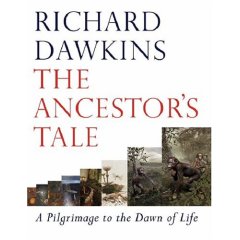The Dawkins dinner was hosted by Standard Bank who threw in an autographed copy of the Ancestor’s Tale to each guest. Of course the financial heavyweights in attendance could all afford to buy their own, but books do lift the tone of the freebie circus and when did you last get something useful and free from a bank?

This is a comet vintage for heavyweight tomes from Oxford dons. Hot on the heels of Roger Penrose’s 1094-page The Road to Reality comes another road book, this one from the UK’s most famous public intellectual Richard Dawkins. Called The Ancestor’s Tale, it weighs in at 528 glossy pages. Interestingly enough the bibliography for the Penrose tome subtitled “a complete guide to the laws of the universe” makes no mention of Dawkins, and visa versa.
While nobody would claim Professor Dawkins got into zoology to pull the wings off butterflies, he does seem to enjoy tormenting his intellectual adversaries which includes religious folk. His previous book is called A Devil’s Chaplain and this one appropriates the device of a medieval pilgrimage, adopting Chaucer’s Canterbury Tales as literary analogue for his latest exposition of evolutionary biology.
Thomas à Beckett’s cathedral is replaced by that location in space-time you arrive at if you run evolution backwards (as you do when you’re an evolutionary biologist). The vaulted medieval apse and transept of a gothic church becomes a microscopic burrow in volcanic glass with traces of carbon of organic origin but no trace of the first micro-organism itself. Stained glass window becomes stained glass. A bit like Dawkins’ view of a cathedral, perhaps.
The book is organized into 40 tales, ten more than Chaucer’s pilgrims who made a pilgrimage to Canterbury in the 14th century. Each tale marks a progression back in time to a common ancestor: from Eve to chimpanzees to tree shrews to sea squirts to drips to cauliflowers ending at the hot primordial rock from which life itself sprang as hyperthermophile bacteria. They’re fascinating tales and confirm time and again that truth is stranger than fiction.
Amidst Dawkins’ scientific credentials, his fellowship of the Royal Society of Literature seems anomalous until you start reading his fluid and exquisitely crafted prose. Not for nothing is this man Professor for the Public Understanding of Science at Oxford and not since Julius Sumner Miller, the archetypical mad professor who popularized chemistry to busloads of school children at RAU in the seventies, have technical arguments been so convincingly exposited.
It’s a much easier book to read than Penrose with colour illustrations galore and nary an equation in sight which helps you to think you know what’s potting even when you haven’t the faintest clue.



